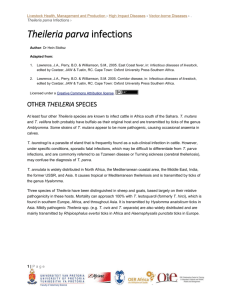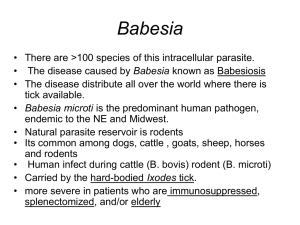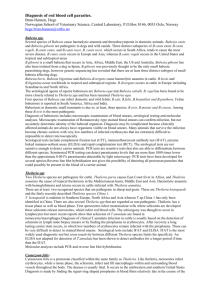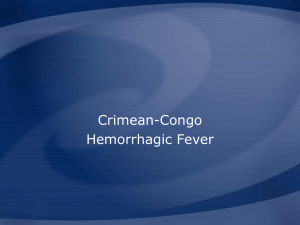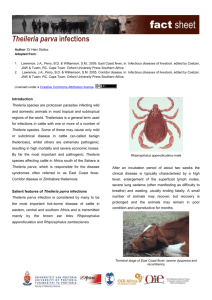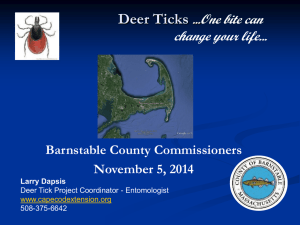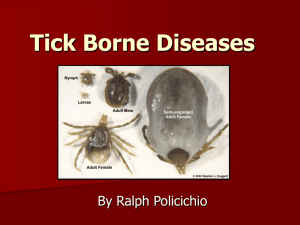Piroplasms
advertisement
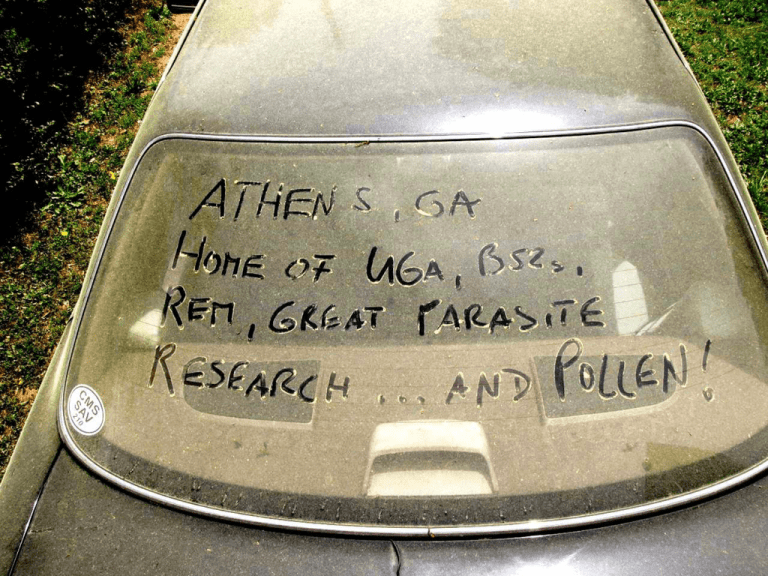
Apicoplast Apicomplexa maintain a chloroplast-like organelle This organelle is the product of an ancient secondary endosymbiosis event (eukaryote ate cyanobacterium producing algae/plants, other eukaryote ate alga) The apicoplast is home to essential biochemical pathways (fatty acids, isoprene and heme) and these are of bacterial origin Drugs targeting the apicoplast are already in use and more are hopefully to be developed Domestication of an endosymbiont involves gene transfer to the nucleus and the establishment of mechanisms to import the proteins encoded by these genes back into the organelle Piroplasms: Babesia & Theileria Piroplasms Piroplasms or Piroplasmida are an order of the Apicomplexa They are very small parasites of mammals and ticks There are two genera which cause import disease in livestock (and occasionally in humans): Babesia & Theileria Devastating outbreaks follow the big cattle drives In the 1860s and 1870s Texas longhorns were driven in huge numbers to the railheads in Kansas (from there they went by train to the slaughterhouses of Chicago and other big nothern cities) Farmers in Kansas and Missouri were plagued by outbreaks of “Texas” fever in their herds which they linked to the cattle drives Several standoffs ensued as local farmers tried to block drives Theobald Smith and Frederick Kilbourne show (1889-1893) that the disease is caused by a protozoan parasite transmitted by ticks (first disease shown to be transmitted by an arthropode) Babesia bigemina causes Texas cattle fever B. bigemina • Mortality in acute untreated cattle 50-90% • Rapid rise in temperature (105-108 F) • Fever persists for a week or more • Loss of appetite, dull, listless • Severe anemia due to rapid loss of red blood cells • Hemoglobinuria (red colored urine) due to massive RBC lysis • Infected RBCs adhere to vasculature of organs (likely similar in mechanisms to Plasmodium) • Evidence for comparable clonal antigenic variation • Cattle may die within 3-8 days Babesia bigemina causes Texas cattle fever • Older cattle is much more likely to develop severe disease than calves • In endemic areas calves get infected and mortality is low • In the case of epidemics adults without previous exposure get infected resulting in massive loss • This explains the massive loss of cattle in Kansas despite the fact that the longhorns coming from Texas (where the disease was endemic) seemed perfectly healthy • What makes the difference between Texas & Kansas? Distribution of Tick fever caused by B. bigemina Babesiosis coincides with the distribution of the main vector ticks Boophilus annulatus & microplus (Winter temperatures limit distribution) Babesia Merozoites (piroplasms) multiply in RBCs of the mamalian host Tick takes up sexual stages with blood meal, gamete formation, fertilization Kinetes infect various organs of the tick including ovary (transovarial infection of next generation of ticks) In the larvae the kinetes invade salivary gland cells, massive replication results in the production of ten thousands of sporozoites which are injected upon feeding Boophilus is a single host tick In the U.S. & Mexico Babesia bigemina is transmitted by Boophilus annulatus Boophilus are one host ticks: larvae hatch from the eggs on the ground and attach to a host Ticks stay on host and feed and molt several times until they are adults Engorged and fertilized female drops of to lay eggs and dies Transovarial infection is very important for effective transmission in one host ticks Disease control is mostly through vector control Disease can be treated with drugs A partially effective attenuated vaccine is available Tick control mostly through pesticide application remains the most important counter measure Vaccination of cows with an antigen from the tick midgut Antigen Bm86 gut Host Salivary gland normal vaccinated Proteins found on the surface of the gut epithelium of Boophilus ticks have be characterized and used to make a recombinant vaccine (against the tick not the parasite) Ticks fed on vaccinated cows are exposed to antibody/complement mediated attack of their epithelium These tick grow poorly and have low fecundity Border Cowboys patrol the U.S. Mexican border for ticks Eddie Dillard, left, and Jack Gilpin are tick riders (NYT 7/03) Boophilus ticks and with them the Texas tick fever have been eradicated from the Southern U.S. but they are still present in Central America USDA employs 60 cowboys which patrol the Southern border to find and check stray-cattle for ticks to prevent the reintroduction See short New York Times feature on border cowboys posted on the class web site Infrequent human babesiosis in the U.S. by B. microti Some species of Babesia (in particular B. microti) that naturally infect small rodents like the whitefooted mouse can also infect humans B. microti is transmited by infected Ixodes ticks (dear ticks) Most transmission occurs along the North-Eastern seaboard and infection rates can be relatively high locally The epidemiological risk factors are very similar to Lyme disease Infrequent human babesiosis in the U.S. by B. microti Human blood film with B. microti, Giemsa stain Vannier & Krause 2009 http://www.hindawi.com/journals/ipid/2009/984568.html Many infections likely go undiagnosed, about a third of the infections are asymptomatic Most infected show mild disease with general malaise and fatigue and fever and chills People who are elderly or immunecompromised (including in particular people without a spleen) are most likely to show severe disease Heavy RBC infection in severe cases can lead to acute respiratory failure, congestive heart failure and other complications with a mortality rate of 510% Babesiosis can be treated with antibiotics that target the apicoplast and/or the parasite mitochondrion Theileria Life cycle and transmission of Theileria Host cell invasion by Theileria -- what are the differences to Toxoplasma East coast fever and tropical theileriosis Theileria manipulates its host cells Theileria cattle: disease Cape buffalo: reservoir Infects mainly ruminants (cattle, goats, sheep) Several different species causing both pathogenic and benign disease Infection in wild animals is mostly asymptomatic Distribution of theileriosis red = T. annulata orange = T. parva grey = T. buffeli/orientalis/sergenti 250 million cattle at risk 50 million cattle at risk relatively benign Life cycle of Theileria spec. Life cycle in tick similar to that of Babesia However, no transovarial transmission (vectors are multihost ticks) Two different cell types are infected in the mammalian blood stream (initially leukocytes later on RBCs) Infection of RBCs is important for transmission and infection of lymphocytes is important for pathology T. parva (mostly T-cells), T. annulata (B-cells, macrophages) Two stages are found in the bovine host: Koch’s bodies and piroplasms Koch’s bodies, infected lymphocytes Piroplasms, infected red blood cells Theileria (sporozoite) invasion differs from Toxoplasma invasion Theileria invasion Zipper mechanism of entry into lymphocyte Escape from vacuole into cytoplas coincides with rhopthry & microneme discharge Parasites free in the cytoplasm associate with host MT Animated version The Theileria paradox Although Theileria replicates in lymphocytes these cells seem to proliferate enormously in infected animals (most of these proliferating lymphocytes are infected) -- this is in contrast to other infections like malaria or babesiosis where parasite replication is associated with the decline of the host cell population causing anemia Also, the sporozoite (injected by the tick) appears to be the only stage capable of invading lymphocytes How can the parasite spread to new lymphocytes? The trick: Theileria hijacks and exploits two key features of the lymphocyte’s cell biology: cell division and growth control Divide & conquer Divide & conquer Parasites do not egress from (and in the process destroy) their host cells and infect new lymphocytes but proliferate along with them The tight association of parasites with host cell microtubules ensures that they are segregated by the host cell mitotic spindle between the two daughter cells A recently divided infected lymphocyte (the arrow indicates the cleavage furrow at which cytokinesis occurred. Blue (DNA), red (host cell centrioles), green (parasite surface membrane), HN (host nucleus) Theileriosis is a lymphoproliferative disease Recall the immunology lecture -- lymphocytes are usually arrested and only expand upon antigen presentation If parasite replication requires host cell replication the parasite has to somehow induce proliferation of its host cells Indeed theileriosis is a lympho-proliferative disease Swelling and proliferation of the lymph node draining the bite site is the first sign of disease Pathology is mainly due to lymphoproliferation Lymphocytes proliferate heavily invading multiple organs causing disease similar to a lymphoma (cancer of lymphocytes) (Top) Infiltration of kidney by Theileria parva infected lymphocytes (Bottom) Abdominal ulcers due to transformed lymphocytes Death is in most cases due to infiltration of the lung resulting in lung edema (the abnormal build up of fluid within the lung) Theileria infected cells show characteristics of transformation Theileria infection seems to share many of the features seen in the transformation of normal cells into cancer cells Uncontrolled growth Loss of differentiation Immortalization (infected cells taken into culture will grow indefinitely) Growth in the absence of external growth factors Enhanced ability to migrate and to infiltrate organs When cells are cured from parasite infection they die (by apoptosis -- this suicide response is usually suppressed in cancer cells) How does Theileria interfere with lymphocyte growth and cause cancer? NF-kB -- a major regulator of lymphocyte growth NFkB (nuclear factor, p50 & p65) is an important and very well studied transcription factor (a protein that interacts with the promoter of genes and stimulates gene expression) It is a major player in the stimulation and clonal expansion of lymphcytes NFkB is bound by IkB (its inhibitor) which retains it in the cytoplasm and keeps it inactive Phosphorylation followed by ubiquitinylation and degradation of IkB leads to import into the nucleus and transcriptional activity Theileria interferes with this pathway by causing the destruction of IkB The IKK complex IkB is tagged for destruction by phosphorylation through the IKK complex In the lymphocytes this provides a way to relay the reception of signals from the surface of the cell to gene expression Theileria hijacks and activates the IKK signaling complex independent of the usually required external stimulation Hijacking and activation of IKK transforms infected cells Theileria parasites (green) interact with and activate IKK (red) of their host lymphocytes IKK tags IkB for destruction NfKb free of its inhibitor enters the nucleus and cells start dividing rapidly summary Theileria sporozoites invade using a zippering mechanism The PV is lysed upon rhoptry secretion and the parasites resides in the cytoplasm and associates with the host cell’s microtubuli & centrosomes When the host cell divides the parasite divides and segregates alongside using the host cell’s mitotic machinery Theileria schizonts transform their hosts lyphocytes (induce uncontrolled ‘cancer-like’ growth) Transformation is parasite dependent and reversible Parasites interfere with NFkB growth control by activating the IKK signalling pathway
